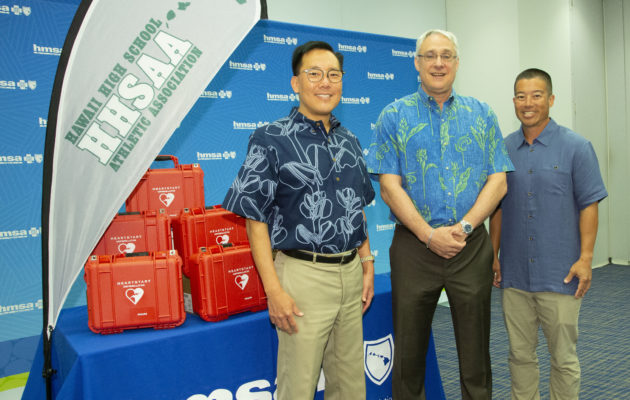
Thirteen years ago, the Hawaii Medical Service Association donated life-saving defibrillators to 95 public and independent schools statewide.
They’re doing the same thing this year in collaboration with the Hawaii High School Athletic Association.
The difference?
Lives have been saved with that first batch of donated defibrillators (also known as automated external defebrillators) in 2006, so whatever doubts, if any, about their importance have been completely wiped away.
According to the HMSA and HHSAA in a joint news release, “AEDs can help restore a normal heart rhythm during a sudden cardiac arrest by sending an electric shock to a victim to restore a heartbeat. According to the American Heart Association, in one year alone, 475,000 Americans die from a cardiac arrest. Globally, cardiac arrest claims more lives than colorectal cancer, breast cancer, prostate cancer, influenza, pneumonia, auto accidents, HIV, firearms, and house fires combined.”
The lists below were compiled by HHSAA executive director Chris Chun with information from some of the 95 schools.
Examples in which lives were saved:
>> ‘Iolani: Used in three instances and saved the lives of a teacher, coach and spectator.
>> Kamehameha-Hawaii: Used on a student with an undiscovered heart defect who survived.
>> Maui High: A coach collapsed during a state baseball game. Trainer used AED. Coach survived.
>> Maui High: Fan had a heart attack during a football game. AED was used by trainer. Spectator survived.
>> Sacred Hearts: Used once and saved a life.
Examples in which a person died:
>> Kaimuki: Used on two security guards, but one guard died last week.
>> Baldwin: Used on a teacher who went into a coma and ultimately died.
>> Kamehameha-Hawaii: Used on a coach who had a heart attack but did not survive.
Other Examples in which either electric shocks were administered or the AEDs were used to monitor heartbeat:
>> Keaau: Used on an adult spectator who had a heart attack.
>> Kapolei: Used on an adult football spectator who had a heart attack.
>> Keeau: Used on a softball athlete who stopped breathing during practice, but shock was not advised at the time.
>> Kapaa: Used on a softball athlete and shock was not advised at the time.
>> Mililani: Used on a softball athlete and shock was not advised at the time.
>> Maui High: AED was brought out to football practice for a heat-related illness.
>> Maui High: AED was precautionary in case situation turned worst.
>> Pearl City Used on a football athlete.
>> Punahou: Used four times. Once, a shock was not advised.
The 320 defibrillators being donated amounts to a $300,000 donation by HMSA to the schools. A news conference was held Wednesday at HMSA Center in Honolulu in which CPR Institute of Indiana president and CEO Bill Callahan demonstrated how to use the AED device.
Like in 2006, once the AEDs are distributed to schools and training is conducted by HHSAA, the life-saving devices will be available for coaches and athletic trainers to use during Hawaii high school sporting events and practices.
“The safety of everyone participating in and attending school sporting events is what matters most,” said the HHSAA’s Chun, who worked on the project with HMSA president and CEO Michael Stollar. “AEDs have already played a vital role at schools for more than a decade and we’re happy to supply them to Hawaii high schools.”
Keith Amemiya, the former HHSAA executive director, worked with Stollar on that first batch of AED donations and he played a role this time around, too.
The $300,000 worth of AEDs is part of Amemiya’s fundraising effort with community and business leaders to fulfull a pledge to donate $1,000,000 each to high school athletic departments statewide (to use however they see fit) for the two years of the historic OIA-ILH interleague football agreement.
“That’s a $300,000 bump,” said Amemiya, who added that the fundraising for this year’s $1,000,000 pledge continues to go well.
Amemiya remembers hearing a trainer sum up the value of the AEDs in 2006:
“He said, ‘It’s not a matter of if we will use them. It’s a matter of when,’ ” Amemiya said.
Amemiya should be in charge of everything. He is that good.